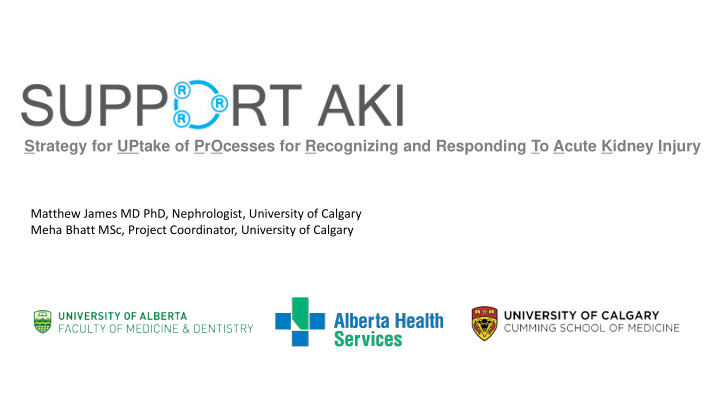



Strategy for UPtake of PrOcesses for Recognizing and Responding To Acute Kidney Injury Matthew James MD PhD, Nephrologist, University of Calgary Meha Bhatt MSc, Project Coordinator, University of Calgary
Overview: Why, What & How? • Why is it important to recognize and manage AKI early? • What will be done as part of the initiative? • How will it be implemented? • Questions and next steps 2
Why?: Rising Incidence of Acute Dialysis 3
Why?: AKI, hospitalization, and costs in Alberta 4
Why?: AKI After Major Surgery in Calgary 20.32% 8.86% 8.05%
Why?: The Clinical Challenge Early intervention begins with early recognition • Symptoms absent at early stage • Scr changes indicating AKI occur in ~40% before SCr “abN” • Possible warning sign (not always): reduced urine production • Fluid balance and medication effects are modifiable: Reduced intake, vomiting, edema, low/high blood pressure, NSAIDs Renal function can continue to decline, unless AKI is recognized and treated 6
Why?: Health Impact on Patients • Adverse outcomes include need for dialysis, chronic kidney disease and end-stage renal disease, mortality 1 • 8.8 times greater risk of developing chronic kidney disease in patients who develop in-hospital AKI 2 • 12.6 times greater risk of mortality in perioperative patients with AKI 3 7 1 Pannu (2013), 2 Coca, Singanamala, & Parikh (2012), 3 Doyle, Ostermann, & Forni, (2016)
What?: The SUPPORT AKI Initiative Recognize • Recognize AKI at its onset and factors Recognize contributing to progression Respond Respond • Early use of IV fluid therapies, medication management, and appropriate monitoring Refer Refer • Resources to guide care and referral when needed Outcome: Reverse injury, Reduce avoidable harm, Restore renal function 8
What?: The SUPPORT AKI Initiative 9
Intravenous Therapies for Hypovolemic Patients Isotonic crystalloids (0.9% NaCl or Ringer’s Lactate) are preferred for initial management for expansion of intravascular volume Diuretics are not recommended to treat AKI, except in the management of volume overload. Boluses of intravenous fluids are considered the most effective strategy for correcting hypovolemia. • Review volume administration safety concerns, determine risk for volume overload, & select bolus volumes • Administer repeat boluses as needed unless signs of volume overload/cardio- respiratory compromise are present
Medication Management Consider stopping flagged medications that affect kidney function Consider adjusting doses for renally cleared drugs for cases of persistent severe AKI (Stage 2 or Stage 3 AKI only) Consult clinical pharmacist if needed
What?: The SUPPORT AKI Initiative AKI alerts • Non-interruptive alerts in SCM based on Scr changes to identify patients at first onset of AKI and progression of severity stage Medication alerts • Flags medications that may be impacting kidney function or those requiring dose adjustment AKI Dashboard • Summarizes information on fluid balance, IV therapies, to guide early intervention. AKI Order Sets • Resource to guide the management of AKI and recommendations for consultation with specialists 12
Recognize
Recognize
Recognize
Recognize 16
Recognize: AKI Alerts 17
Recognize: Medication Alerts 18
Recognize: AKI Dashboard 19
Recognize: AKI Dashboard 20
Recognize: AKI Dashboard 21
Respond: AKI Order Set
Respond: AKI Order Set
Refer: AKI Order Set
Contact us: Study inquiries or feedback about the tools and processes? Meha Bhatt, Project Coordinator meha.bhatt@ucalgary.ca
Recommend
More recommend